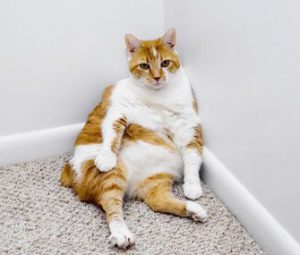The Vet is In:
Obesity is Not “Cute.” Keep Your Pets Trim

Our human population has become increasingly obese, and with that physical change, we have saddled ourselves with multiple health issues that are the inevitable consequence. Physical damage (osteoarthritis, fatty infiltration of the liver) and hormonal changes (diabetes mellitus) shorten our longevity and increase the costs of keeping ourselves going. Similarly, we are wreaking the same damage on our companion animals with the same consequences: despite gentle instruction given at the time of the first kitten and puppy visit, and then firmer warnings with successive annual appointments, 56% of dogs and 59% of cats are overweight or obese in this country, according to the Association for Pet Obesity Prevention.
As a veterinarian, I find this trend distressing and reprehensible. Clients who permit their large or giant-breed dog to become so overweight that he/she tears the stifle joint’s “CCL” (cranial cruciate ligament) have created a condition with extreme pain, requiring surgery costing $2,000 – $5,000, plus months for proper rehabilitation. They have imposed a long period of suffering on their dog that was preventable — and expensive. The cat guardians who leave dry food available “24/7” are very likely to find themselves dealing with a future obese diabetic, requiring extensive blood-testing and daily insulin injections — no fun for the giver or the receiver.
 Obesity changes an animal’s life, even before the dire health consequences develop. Cats, who are fastidious about their fur-care, can no longer groom themselves and develop clumped fur (which tugs at their skin) and seborrhea (i.e. flaky skin, either dry or oily). As a members of a species that has evolved to be lithe climbers, able to leap from branch to branch, they become instead couch potatoes who have difficulty with stairs. Dogs (also an athletic species) have similarly become so heavy that their joints break down and they too face a lifetime of unnecessary pain in which even the simple act of defecation becomes a struggle. Obesity impairs locomotion, respiratory health, and liver function, and creates diabetes, hypertension, heat stress, and anesthetic risks—to name just a few of the ills that develop due to excess weight.
Obesity changes an animal’s life, even before the dire health consequences develop. Cats, who are fastidious about their fur-care, can no longer groom themselves and develop clumped fur (which tugs at their skin) and seborrhea (i.e. flaky skin, either dry or oily). As a members of a species that has evolved to be lithe climbers, able to leap from branch to branch, they become instead couch potatoes who have difficulty with stairs. Dogs (also an athletic species) have similarly become so heavy that their joints break down and they too face a lifetime of unnecessary pain in which even the simple act of defecation becomes a struggle. Obesity impairs locomotion, respiratory health, and liver function, and creates diabetes, hypertension, heat stress, and anesthetic risks—to name just a few of the ills that develop due to excess weight.
What I find baffling is that humans do not see their companions’ obesity as it develops, and are not sensitive to their pets’ discomfort. I find that I have to show owners a picture of what is normal (such as is shown in the Nestle Purina Body Condition System chart for dogs and chart for cats) and where their animal falls in this continuum. I discuss adjusting their pet’s diet to a healthier source, formulation, and daily intake. If I am able to persuade the owner, I may be gratified to see the companions get thinner with future visits and regain their health and athletic abilities. Unfortunately, more often my entreaties are countered by the pleading eyes of their pet at the next meal time, and the human just can’t say no.
Obesity is not “cute.” It is not funny. As responsible guardians of our animal companions, keeping them trim should be one of our first missions. Please evaluate the ingredients and calorie content of their treats as well as their primary food source, as this is often the cause of the extra weight gain when owners are doing well with their choice of the main meal. Please remember that pet food companies tend to recommend more cups of food per day than is advisable. We veterinarians can only advise…and hope that our clients care enough about their pets’ health to take our advice.
Please spread the word!
Holly Cheever, DVM
NYSHA’s VP, Dr. Holly Cheever, is a partner in a small animal practice, the Village Animal Clinic, in Voorheesville, NY. She sits on several boards for animal issues, is a speaker and consultant across the nation, and has testified before Congress about animal abuse in circuses, as well as in New York City regarding the carriage horse trade.
New York State Humane Association Humane Review, Vol. XXXI, Fall 2017